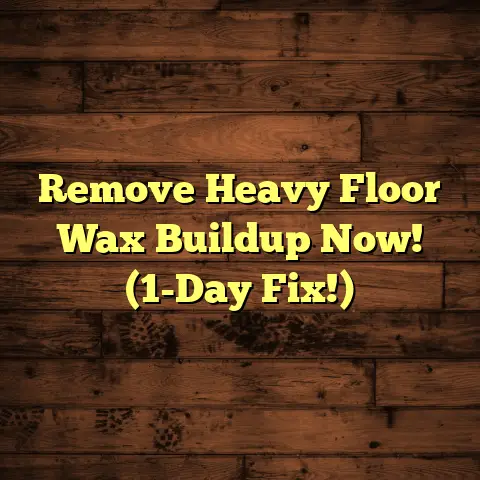Kid Peed on the Floor? (1 Urgent Action!)
Okay, picture this: You’re walking into the living room, maybe with a cup of coffee in hand, ready to finally relax after a long day. And then… BAM!
You see it. A puddle. A puddle of pee. Your kid had an accident. Ugh! I’ve been there, more times than I care to admit. That initial wave of emotion?
It’s a cocktail of shock, frustration, and maybe even a little embarrassment, especially if you have guests over (trust me, I know!). But before you spiral, take a deep breath.
This is a common childhood experience. It happens. And it’s manageable. The key is to react calmly and effectively. Because honestly, how you handle this situation can turn a stressful moment into a learning opportunity for both you and your child.
As a flooring contractor, I’ve seen firsthand the damage that can occur when these accidents aren’t handled properly. So, let’s dive into the one urgent action you need to take and how to do it right.
Section 1: Understanding the Situation
1.1 The Child’s Perspective:
Why do kids have accidents? It’s not always about defiance. There are several reasons:
-
Potty Training Stages: Let’s be real, potty training is a journey, not a destination. There are setbacks, plateaus, and sometimes, full-on reversals. It’s all part of the process.
-
Distractions: Kids get so absorbed in what they’re doing. A game, a TV show, building a tower of blocks… Suddenly, the urge to pee takes a backseat to the immediate fun.
-
Medical Issues: Sometimes, accidents can be a sign of an underlying medical issue, like a urinary tract infection (UTI) or constipation. It’s always a good idea to rule these out with your pediatrician, especially if accidents are frequent or accompanied by other symptoms.
-
Emotional Factors: Stress, anxiety, or even excitement can sometimes trigger accidents. Think about any recent changes in your child’s life, like starting a new school or welcoming a new sibling.
1.2 The Parent’s Reaction:
Okay, let’s be honest. Our initial reaction isn’t always sunshine and rainbows. It’s easy to get frustrated, especially when you’re already dealing with a million other things. But here’s the thing: your reaction matters.
Yelling or scolding can make your child feel ashamed and anxious, which can actually increase the likelihood of future accidents. Instead, try to remain calm. I know, easier said than done, right?
But remember, your child isn’t trying to upset you. They’re learning, and they need your support and understanding. A gentle reminder about using the toilet next time, coupled with a reassuring hug, can go a long way.
Section 2: The Urgent Action – Clean Up Immediately
2.1 The Immediate Response:
Alright, here it is: The one urgent action you need to take when you discover that puddle of pee? Clean it up immediately!
I know it sounds obvious, but trust me, procrastination is your enemy here. The longer urine sits on your floor, the more likely it is to cause stains, odors, and potentially permanent damage.
Think about it: urine is acidic. It can eat away at certain finishes, seep into porous materials, and create a breeding ground for bacteria. Not a pretty picture, is it?
2.2 Cleaning Supplies Needed:
Before you start scrubbing, gather your supplies. Here’s what you’ll need:
-
Enzymatic Cleaner: This is your secret weapon. Enzymatic cleaners contain enzymes that break down the uric acid in urine, which is what causes the lingering odor. Avoid cleaners with ammonia, as ammonia is present in urine. Using ammonia-based cleaners can actually worsen the smell.
- Pro Tip: Look for enzymatic cleaners specifically designed for pet urine. They’re usually more potent and effective. I like Nature’s Miracle and Rocco & Roxie Stain & Odor Eliminator.
- Paper Towels or Cleaning Cloths: Stock up on these. You’ll need plenty for blotting and wiping. Microfiber cloths are great because they’re absorbent and reusable.
- Rubber Gloves: Protect your hands! Urine can contain bacteria, and some cleaning solutions can be harsh on your skin.
- Spray Bottle: If your enzymatic cleaner doesn’t come in a spray bottle, you’ll need one to apply the solution evenly.
- Water: For rinsing the area after cleaning.
- Baking Soda (Optional): Baking soda is a natural odor absorber. You can sprinkle it on the area after cleaning to help eliminate any lingering smells.
- Vacuum Cleaner (Optional): For carpets, a vacuum cleaner can help remove any remaining residue after the area has dried.
2.3 Step-by-Step Cleaning Process:
Okay, let’s get down to business. Here’s a step-by-step guide on how to clean up that mess:
- Blot, Blot, Blot: Immediately blot up as much urine as possible with paper towels or cleaning cloths. The more you can absorb initially, the less likely it is to soak into the flooring. Apply pressure and keep blotting until the area is as dry as possible.
- Saturate the Area: Generously spray the affected area with your enzymatic cleaner. Make sure you saturate the area thoroughly, going beyond the visible stain. The goal is to reach all the urine that may have seeped into the flooring or padding.
- Let It Sit: This is crucial. Follow the manufacturer’s instructions on the enzymatic cleaner bottle for how long to let the solution sit. Typically, it’s around 10-15 minutes. This allows the enzymes to break down the uric acid and eliminate the odor.
- Blot Again: After the solution has sat for the recommended time, blot up any excess liquid with clean paper towels or cloths. Again, apply pressure to absorb as much as possible.
- Rinse (If Necessary): Some flooring types, like tile or linoleum, may benefit from a quick rinse with clean water after cleaning. Use a damp cloth to wipe the area, then dry it thoroughly.
- Dry Thoroughly: This is essential to prevent mold or mildew growth. Use clean, dry towels to absorb any remaining moisture. You can also use a fan to speed up the drying process.
- Baking Soda (Optional): Once the area is dry, sprinkle baking soda over it. Let it sit for several hours or overnight to absorb any lingering odors. Then, vacuum it up.
2.4 Specific Flooring Types:
The cleaning method may need to be tweaked depending on your flooring type. Here’s a breakdown:
-
Hardwood Floors: Hardwood is particularly vulnerable to urine damage. The key is to act fast!
- Urgent Action: Blot immediately.
- Cleaning: Use an enzymatic cleaner specifically designed for hardwood floors. Avoid using excessive amounts of water, as it can warp the wood.
- Prevention: Consider applying a sealant to your hardwood floors to protect them from moisture.
- Professional Help: If the urine has penetrated the finish, you may need to have the floors professionally refinished.
-
Carpet: Carpet is notorious for trapping urine and odors.
-
Urgent Action: Blot immediately.
- Cleaning: Use an enzymatic cleaner specifically designed for carpets. Saturate the area thoroughly, making sure the cleaner reaches the padding underneath. Use a carpet cleaner or wet vacuum to extract the liquid.
- Prevention: Consider using a waterproof carpet pad to protect your subfloor.
- Professional Help: If the odor persists, you may need to have your carpets professionally cleaned or even replaced.
-
Tile: Tile is generally more resistant to urine damage, but the grout can be porous and absorb odors.
-
Urgent Action: Wipe up the urine immediately.
- Cleaning: Use an enzymatic cleaner or a solution of bleach and water (1 part bleach to 10 parts water). Apply the solution to the grout and let it sit for a few minutes before scrubbing with a brush.
- Prevention: Seal your grout to prevent it from absorbing stains and odors.
-
Laminate: Laminate is relatively easy to clean, but it’s important to avoid excessive moisture.
-
Urgent Action: Wipe up the urine immediately.
- Cleaning: Use an enzymatic cleaner or a solution of vinegar and water (1 part vinegar to 1 part water). Avoid using abrasive cleaners, as they can scratch the surface.
- Prevention: Clean up spills immediately to prevent them from seeping into the seams.
-
Vinyl: Vinyl is waterproof and easy to clean.
-
Urgent Action: Wipe up the urine immediately.
- Cleaning: Use an enzymatic cleaner or a solution of soap and water.
- Prevention: Vinyl is relatively low-maintenance, but it’s still important to clean up spills promptly.
Table: Cleaning Methods by Flooring Type
| Flooring Type | Urgent Action | Cleaning Solution | Prevention |
|---|---|---|---|
| Hardwood | Blot Immediately | Enzymatic Cleaner (Hardwood) | Sealant |
| Carpet | Blot Immediately | Enzymatic Cleaner (Carpet) | Waterproof Carpet Pad |
| Tile | Wipe Immediately | Enzymatic Cleaner or Bleach/Water | Seal Grout |
| Laminate | Wipe Immediately | Enzymatic Cleaner or Vinegar/Water | Clean Spills Promptly |
| Vinyl | Wipe Immediately | Enzymatic Cleaner or Soap/Water | Clean Spills Promptly |
Section 3: Preventing Future Incidents
Okay, you’ve cleaned up the mess. Now, let’s talk about prevention.
3.1 Creating a Positive Potty Training Environment:
Potty training should be a positive experience, not a battleground. Here are some tips:
- Positive Reinforcement: Praise your child for their successes, no matter how small. Use stickers, charts, or small rewards to motivate them.
- Avoid Punishment: Never punish your child for having accidents. This can create anxiety and make potty training even more difficult.
- Make It Fun: Use books, games, or songs to make potty training more enjoyable.
- Consistency is Key: Stick to a consistent routine and use the same language and cues.
3.2 Setting Up a Reminders System:
Sometimes, kids simply forget to go to the bathroom. A reminders system can help:
- Timed Reminders: Set a timer to remind your child to go to the bathroom every 2-3 hours.
- Visual Cues: Use visual cues, like pictures or signs, to remind your child to use the toilet.
- Potty Chart: Create a potty chart where your child can track their successes.
3.3 Understanding Physical and Emotional Readiness:
Before you start potty training, make sure your child is physically and emotionally ready. Signs of readiness include:
- Physical Readiness:
- Staying dry for longer periods of time (at least 2 hours).
- Having regular and predictable bowel movements.
- Being able to pull their pants up and down.
- Emotional Readiness:
- Showing an interest in using the toilet.
- Expressing a desire to be dry.
- Being able to follow simple instructions.
Statistics: Potty Training Readiness
According to the American Academy of Pediatrics, most children are ready to begin potty training between 18 months and 3 years of age. However, every child is different, and some may be ready earlier or later.
Section 4: When to Seek Additional Help
Most accidents are normal and nothing to worry about. But sometimes, they can be a sign of a deeper issue.
4.1 Identifying Underlying Issues:
Consult your pediatrician if:
- Frequent Accidents: Your child is having frequent accidents despite being potty trained for several months.
- Sudden Changes in Behavior: Your child suddenly starts having accidents after being dry for a long period of time.
- Painful Urination: Your child complains of pain or burning when urinating.
- Blood in Urine: You notice blood in your child’s urine.
- Constipation: Your child is frequently constipated.
- Behavioral Issues: Your child is experiencing behavioral issues, such as anxiety or depression.
4.2 Resources for Parents:
Here are some resources for parents seeking more information on potty training or behavioral issues:
- Books:
- “Oh Crap! Potty Training” by Jamie Glowacki
- “Potty Training in 3 Days” by Carol Cline
- Websites:
- American Academy of Pediatrics (AAP): https://www.aap.org/
- Zero to Three: https://www.zerotothree.org/
- Local Parenting Groups: Check with your local hospital or community center for parenting groups in your area.
Section 5: Turning Accidents into Learning Opportunities
Accidents don’t have to be a source of stress. They can also be a chance to teach your child valuable lessons.
5.1 Teaching Responsibility:
Involve your child in the cleanup process (age permitting). They can help you gather supplies, wipe up spills, or throw away soiled paper towels. This teaches them responsibility for their actions.
5.2 Building Confidence:
Focus on reinforcing positive behavior and building your child’s confidence. Praise them when they use the toilet successfully and remind them that accidents are okay and everyone makes mistakes.
Conclusion: Embracing the Journey
Potty training is a journey, not a race. There will be ups and downs, successes and setbacks. But remember, accidents are a normal part of childhood and parenting.
Embrace these moments as opportunities for growth and learning. By responding with patience, understanding, and a little bit of cleaning know-how, you can foster a supportive environment for your child and navigate the potty training process with confidence. And hey, at least you now know exactly what to do when you encounter that inevitable puddle!





